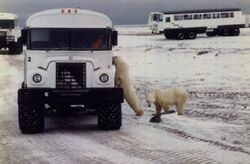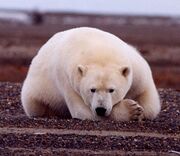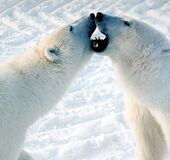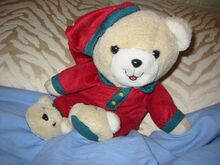Bipolar bear
Bipolar bears, also known as north-south bears or nanuq-depressive bears in the Inuit language, are a bear species native to both the Arctic and Antarctic. Bipolar bears migrate between the north and south poles so that they remain in winter conditions year-round. They likewise alternate between “high” states of mania (in the north) and “low” states of depression (in the south). Why these geographically-determined mood swings should be polar in nature has baffled conservationists and animal psychiatrists alike.
It is a common misperception that bipolar bears live only in the north, where they are often observed behaving in a wild, unpredictable manner – climbing icebergs, violently smashing inukshuks, hunting to the point of depleting fish stocks, leaping over igloos, and more than once staging a coup against the Nunavut government. Conversely, they have rarely been sighted in Antarctica, which psychiatrists attribute to depression-induced isolation; though others suggest that the lack of southern sightings is merely due to the fact that few humans live in Antarctica to observe them.*[1]
The manic pole
Bears living in the north tend to act in a manner suggesting elation, euphoria, irritation, and/or suspicion. They have substantial energy and can roar non-stop for hours. They develop grandiose ideas, some of which have led to recent conflicts with various human governments; for example, in 2003 several bipolar bears occupied Hans Island, tore down both the Danish and Canadian flags, drank the Danish and Canadian liquor left at the base of the flags, and refused to leave. This created an international crisis, but tensions eased when the bears went south for the summer to shoot heroin and watch blue collar T.V. A further incident occurred at the North Pole in December 2005, when the bears began unwrapping Christmas presents days before they were to be delivered, and demanded that the reindeer teach them to fly. It was at this point that an international team of psychiatrists came forward and offered them medication under the pretence they were “flying pills.” Indeed, the bears were satisfied with their floating experience, though observers insisted they never left the ground.
The depressive pole
Psychiatrists in Antarctica describe bipolar bears as experiencing “sadness, guilt, isolation, loneliness, fatigue, and lack of motivation.” Wildlife biologists describe them as “hibernating.” Nonetheless, therapists have been sent in to see if they could assist the depressed animals, with little success; though on one occasion a group of nearby penguins were very relieved to let out the bitter emotional pain behind their life stories. No cause of the bears’ depression could be discerned; indeed, their more-than-adequate supply of fur and blubber tended to keep them well insulated from any disparaging remarks aimed their way. Furthermore, the bears were not forthcoming about their depression; they kept whatever was inside them well camouflaged.
Possible explanations
It has been hypothesized that bipolar bears suffer from seasonal affective disorder, though this theory does not explain why they are depressed during the southern winter but manic in the northern winter. A more popular theory is that their state of mind is diet-related: that “there is something fishy in the seal meat” common in northern areas; and that the fresh humans ingested contain large amounts of unnatural substances, resulting in infection from second-hand beer. Conversely, even researchers in the south found a diet of pure penguin meat to be “dull and demoralizing.”
Mating
Mating occurs in both hemispheres, but is much more common in the Arctic. Antarctic mating is lethargic in nature: "Honey, you want to have sex?" "Whatever. If it turns you on. Just let me know when you're done"; whereas Arctic mating is more of the "Shall we do it an eighth time?" "Lets!!" variety. Occasionally one throws all caution to the wind and gets it on with a grizzly.[1]
Bipolar bears have even been known to try to copy human mating rituals, though at times this is quite awkward. They seem to find human flirting rituals confusing, and have even injured themselves trying to seductively remove their fur. They have, however, become somewhat expert at pole dancing.
A distinction should be made between bipolar bears and bi-polar bears. The latter are ordinary polar bears who are attracted to both sexes; whereas the former are manic-depressive, but can be of any sexual orientation. The confusion is exacerbated by the fact that, when in the manic state, bipolar bears are willing to have sex with just about anyone or anything.
Bipolar bears in popular culture
- Bipolar Teddy bears have become quite popular in the southern hemisphere, where they appear cute and cuddly and happy as if nothing were wrong. However, those that have been taken to the northern hemisphere have been known to rally other stuffed animals to revolt and even eat children. On occasion, this has led to a "stuffed bear hunt" in which men with rifles have blown away the little bears to the horror of onlooking children. The stuffed bear hunt is highly controversial, though hunters insist they are merely trying to control the stuffed bipolar bear population.
- Goldilocks and the Three Bipolar Bears opened the Stockholm Drama Festival in 2007. The bears became incensed when they noticed that Goldilocks had eaten all three bowls of porridge. They looked hungrily toward the braided actress, but the director convinced them to perform their dancing bear routine instead. Their wild leaps and jumps, along with their tango-quickstep-samba combo to In the Mood Swing earned them a standing ovulation.
- Coca-Cola uses bipolar bears in its advertising. It is apparent that they must be bipolar bears, because naturally Coke would not be so ignorant as to feature ordinary polar bears in the same habitat as penguins.
- The Canadian $2.00 coin pictures the bear on both sides, one in its depressed state (shown) and one in its manic state.[2]
- Although the Muppets' Fozzie Bear clearly shows signs of both mania and depression, he cannot be of the bipolar bear species because he illustrates both qualities in the same location (which does not mean that The Muppets is filmed on the equator). He might be a bipolar bear but is not a bipolar bear.
- A virtual band called The Bipolar Bears have been number one in popular download sites such as download.com, mp3.com and independencemusic.net. The singles Rain, Rain, Rain, Take Me Away, Asphyxiated, and Big Fish have helped them gain a worldwide cult following.
Conservation status
The debate as to whether bipolar bears are endangered tends to be polarized. Conservationists on the one hand demand that they be protected, whereas conservatives on the other insist that thay cannot possibly be endangered because they never existed in the first place. The conservatives' stance resulted in a strongly worded letter from the Assembly of Bipolar Bears, to which one noted conservative (OK, just Dick Cheney) replied "if they think they exist, they're probably delusional." The bears responded that they were putting him on their endangered list. A spokeswoman for the Sierra Club made it clear that they did not consider Mr. Cheney to be endangered (except possibly at his own hands); and even if he were, they were not inclined to protect him from extinction.
The issue will be further debated at the 3478th annual Bipolar Bear Convention slated for January 14-17, 2008 on Spitsbergen Island, Norway. Several notable conservatives have been invited to a dinner-debate, appropriately themed "Survival in the Wild."
References and Footnotes
- ↑ http://news.nationalgeographic.com/news/2006/05/polar-bears.html National Geographic: "Grizzly-Polar Bear Hybrid Found -- But What Does It Mean?" May 16, 2006
- ↑ The queen is not amused.
See also
| Featured version: 5 July 2007 | |
| This article has been featured on the main page. — You can vote for or nominate your favourite articles at Uncyclopedia:VFH. | |





